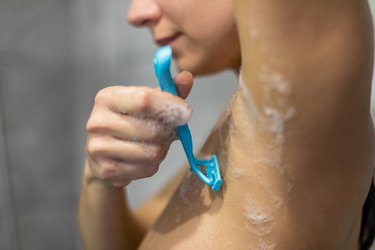
Many of us have dealt with pesky ingrown hairs — when hair grows into the skin rather than out — at some point in our lives. But squeezing, yanking or picking at the resulting bumps isn't the best idea: There are safer ingrown hair treatments to try.
Here's what you need to know about the condition, including the symptoms, causes and how to treat an ingrown hair (or better yet, prevent it in the first place).
Video of the Day
Video of the Day
What Is an Ingrown Hair?
"Ingrown hairs can happen when hair grows back into the hair follicle [instead of out of the skin]," Mary L. Stevenson, MD, dermatologic surgeon and assistant professor at the NYU Grossman School of Medicine, tells LIVESTRONG.com.
"Ingrown hairs can also be caused when dead skin clogs the follicle and the hair that is meant to grow out gets trapped," Dr. Stevenson adds. "The follicle can then get inflamed and you get a red, irritated bump."
According to Dr. Stevenson and the Mayo Clinic, ingrown hairs can especially be a problem for the following people:
- Those with thick or curly hair
- Black people who shave their facial hair
- People who shave their heads, cheeks, chin, neck, pubic area, armpits and legs
Ingrown hairs can occur on several places on your body, including your armpits, groin, face/head and legs. Here's what an ingrown hair looks like: It's typically a red bump with a head filled with pus, per the Cleveland Clinic.
Symptoms
The most common symptom of ingrown hairs is inflamed skin and redness, per the Mayo Clinic. Other signs include:
- Skin darkening
- Pain
- Itching
- Embedded hairs
- Small, pus-filled, blister-like lesions (pustules)
- Small, solid, rounded bumps (papules)
Chronic ingrown hairs can also cause the following complications, according to the Mayo Clinic:
- Ingrown hair infection
- Skin darkening
- Permanent scarring
- Razor bumps
- Ingrown hair boils
How Long Do Ingrown Hairs Last?
A deep ingrown hair will last longer than a shallower one, but in general, you can expect it to last between one and six months, per the Mayo Clinic.
Causes of Ingrown Hairs
Hair removal is the most common cause of ingrown hairs, particularly "methods like shaving, waxing or tweezing," Dr. Stevenson says.
But hair removal isn't the only culprit. According to the Cleveland Clinic, other causes of ingrown hairs include:
- Products that clog pores (like deodorant or shaving blades with built-in soap or conditioning strips)
- Sweating a lot without showering right away (especially after shaving)
Tip
An ingrown hair cyst is different from acne because you can usually see the hair inside the bump, per the Cleveland Clinic.
How to Prevent Ingrown Hairs
If you shave, tweeze or wax your hair, you do run the risk of ingrown hairs. But there are things you can do to lessen your chances of getting them, including:
1. Try Laser Hair Removal
Switching up your hair removal method may help prevent ingrown hairs.
"One of the best ingrown hair treatments is laser hair removal, which effectively kills the hair within the follicle by targeting the pigment in the hair and therefore preventing hairs from growing," Dr. Stevenson says.
2. Tweak Your Shaving Habits
Making a few changes to your shaving routine may also help keep ingrown hairs at bay.
"Other ways you can prevent ingrown hairs include shaving in the direction of hair growth — which we frequently do not do — and using a single-blade razor," Dr. Stevenson says."You can also use a shave guard, which does not allow for as close a shave."
Try This Razor
Gillette Venus Razor Bikini Trimmer ($13.99, Amazon.com)
3. Exfoliate
Regular exfoliation is a natural ingrown hair remedy that can help minimize the occurrence of these bumps by removing dead skin cells that may otherwise clog your pores.
Exfoliating with products that contain salicylic acid or beta hydroxyls is best, per the Cleveland Clinic.
4. Open Up Your Pores
Because clogged pores increase the likelihood of getting ingrown hairs, opening up your pores can help.
Steaming your hair follicles in the shower can reduce the risk for irritation, per the Cleveland Clinic. That means shaving toward the end of your shower, to give the steam time to open your pores.
5. Don't Remove Your Hair
Avoid shaving, tweezing and waxing to prevent ingrown hairs entirely, according to the Mayo Clinic.
How to Treat an Ingrown Hair
An ingrown hair often heals on its own, according to Cedars-Sinai. But there are a few ingrown hair removal techniques to call on if need be.
First: Resist the urge to pick at them, especially if there's pus, which is a sign that there's a slight infection, per the Cleveland Clinic.
Instead, try one of these safe ingrown hair treatments, according to the Cleveland Clinic:
- Use an electric trimmer to remove hair
- Apply warm compresses to the infected skin
- Use products that remove hair without having to shave
To release an ingrown hair, wash the affected area with a washcloth or soft-bristled toothbrush and use a circular motion for several minutes before shaving and at bedtime, per the Mayo Clinic.
Tip
For occasional ingrown hairs, at-home treatments are a good option. But talk to your doctor if it's a constant problem. "If you have persistent, bothersome ingrowns, you should see a board-certified dermatologist to discuss the problem and figure out management," Dr. Stevenson says.
Was this article helpful?
150 Characters Max
0/150
Thank you for sharing!
Thank you for your feedback!
Is this an emergency? If you are experiencing serious medical symptoms, please see the National Library of Medicine’s list of signs you need emergency medical attention or call 911.